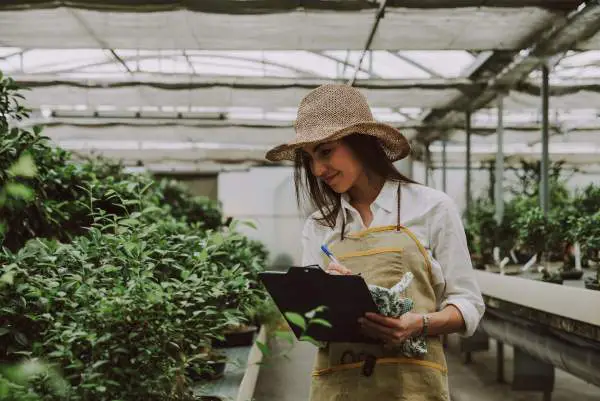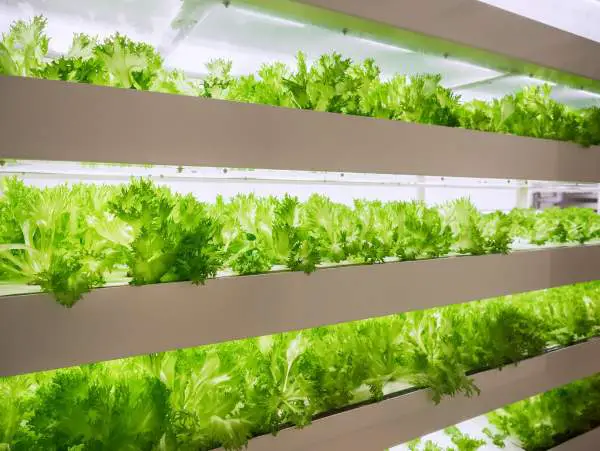As we look at new methods of food production, vertical farming comes up a lot. Vertical farming leverages controlled environments and hydroponics to grow plants. Many vertical farm structures are called ‘skyscrapers’ because of their tall, stacked formation.
Looking at some of these high-tech indoor farms can feel like you’re looking at the future through a window in the present day. It’s no future feat, however. Vertical farms are popping up across the globe in a movement for urban agriculture.
It does beg the question though, is vertical farming sustainable?
Weighing sustainability
When people say ‘sustainable,’ they can really mean a number of different things. Some people are thinking in purely ecological terms (i.e. what does this do to the environment?, how does this help combat climate change?). Others are thinking in economic and supply chain terms (i.e. will the revenues outweigh expenses?). And last, some people are thinking about social sustainability and food security (i.e. will certain populations support this?).
Here’s the thing:
All three aspects are important for anything to be truly sustainable. If a farm is popular but damaging to the surrounding environment, that won’t work. Nor will a farm that has no effect on the ecosystem, but is too expensive to operate.
There’s another kind of sustainability we need to talk about, too:
Biological sustainability. This has much less to do with how a vertical farm will impact its external surroundings and much more to do with the factors going on inside the farm. The way vertical farming is set up provides a perfectly balanced environment where the flora can thrive with minimal intervention outside of routine maintenance.
What resources does vertical farming use?
To determine whether or not something is sustainable, we also need to look at the resources it uses. Vertical farming doesn’t use much land, but it still needs resources to operate. Here are the main resources these farms use:
A Suitable Building
This is one of the most negligible resources that vertical farming requires. They use barely any land and can be installed in otherwise unused buildings.
Energy
Vertical farming uses a lot of electricity, which is a critique we’ll talk about more in-depth later. As a resource, using electrical energy rather than fuel or coal is still highly preferable when we’re concerned about environmental impact.
Read more: How much electricity does hydroponics use?
Water
Vertical farming uses less water than outdoor farming, but water is still a huge factor in the success of a farm. Without a clean, reliable water connection, a vertical farm won’t be able to thrive.
“Fertilizer” (plant food)
The fertilizer or nutrient solution is dissolved into water and delivered to plants hydroponically. Since the nutrient levels are regulated and optimized for crops, vertical farms can produce higher yields and crops that contain their full nutritional capacity.
Capital
A small, vertical home garden doesn’t have to cost much. On the other hand, developing a commercial-scale vertical farm can be either a moderate cost or an enormous investment. While there is a significant initial investment, most commercial vertical farms can still produce at least a 30% return on investment (ROI) within their first year.
Human Labor
At present, vertical farming still requires human labor. Again, the amount of this resource that’s needed is less than a traditional farm, but it can’t be overlooked. The amount of labor needed will be different according to each vertical farm’s level of automation.
Also see: Beginners Guide to Vertical Farming
Countering critiques about the sustainability of vertical farms
Some arguments against vertical farms come up when we’re talking about whether or not they’re sustainable. While some things, like water, never really come into the conversation, things like power usage are a staple criticism of vertical farms. In fact, electricity consumption is a top argument against vertical farms at the moment.
To be fair, electricity is the top expense of a vertical farm. That being said, vertical farms use about as much energy as the average commercial greenhouse of comparable size. When you add that fact in, we really aren’t talking about just vertical farms anymore. Then, we’re talking more about how we need to improve energy efficiency in indoor farming in general.
Even our home lighting has become more efficient in only a short time, as have our electrical systems. A huge part of sustainability is innovation, right alongside progress, which we also have to apply to our food production.
The crops vertical farms produce
So far, many vertical farms produce mostly greens. In most commercial vertical farms crops like kale, spinach, lettuce, and leafy herbs are staples. For those that argue against vertical farms’ sustainability, limited crop diversity is a big part of the stance. Obviously, we can’t sustain a population on lettuce alone. In its very essence, this argument makes sense. But it also neglects some important points:
First, while leafy greens are currently more common in vertical farms, they aren’t the only crop grown. Vertical farms have the ability to produce a wide variety of crops, such as squash, peppers, strawberries, and more. There are even some companies working to create vertical farms that can produce other staple foods like wheat and grains.
Then, we need to consider that as long as the crops aren’t wasted, even leafy greens would otherwise be grown elsewhere and transported in. Producing a needless surplus of a crop is one thing, and filling an existing need is another entirely.
The food is too expensive
Right now, produce from vertical farms is more expensive than products from other farms (at least in most parts of the world). That gives people the idea that these crops are a sort of ‘designer’ food, meant for small delicacies like micro salads. In some urban areas, that may be the case.
However, in other heavily populated areas like Japan, vertical farms have been established to provide affordable sustenance to urban areas. The Espec Mic vertical farm in Japan produces 1,000 lettuce heads daily, alongside other vegetables, which go to feed a hungry population. The crops grown here are actually on par with crops that are grown traditionally in terms of cost.
When we talk about the food being too expensive, we’re dealing with issues of economic and social sustainability. Like any other business, a vertical farm has to turn a profit to continue. For a commercial-grade vertical farm, there can be a pretty substantial start-up cost. In attempts to recoup some of these costs, their product is going to be more expensive at the beginning (like many other companies). With the continued operation, production, and innovation, we can expect costs to go down naturally.
In terms of social sustainability, the issue of cost can be more complicated. Part of creating a social atmosphere that promotes vertical farms is recognizing them as a healthy, eco-friendly solution to food production (where we don’t have to worry about pests and chemicals, either). When the health benefits are seen to outweigh the initial costs, produce from vertical farms will be commonplace.
Factors that make vertical farming sustainable
Despite any arguments, vertical farming has a ton of qualities that practically scream ‘sustainable!’ Yes, we can always improve what we’ve already got going, but here’s what makes vertical farming sustainable (already):
Water Usage
This is perhaps the biggest factor that wins the title of sustainability for vertical farms. Agriculture requires a lot of water, no matter how you’re farming. With that in mind, there’s also a huge difference in the actual volume of water used in traditional farming vs hydroponics or aeroponics. In traditional agriculture, there isn’t much to be done about wasted water. Water delivery systems can be improved, but runoff water really can’t be recycled and reused.
In hydroponics (vertical farms use one hydroponic system or another), much less water is initially used. From that, the runoff and excess water is most often drained and recycled.
Some vertical farms use less than 1% of the water used by traditional agriculture.
Efficient Use of Space
Vertical farms use space, but not in the way that normal, field farm does. Instead, they use vertical real estate that takes up very little ground space. A single building housing a vertical farm can be several stories tall to maximize the growing space.
Even better, vertical farms can be established in warehouses and other unused buildings (which otherwise stand empty and crowd valuable urban space). Rather than the expense of demolishing an unused building, or leaving valuable real estate unused, a space can be made to produce food for the surrounding community.
The relatively small amount of space that vertical farms are important for a few reasons. First, urban areas are experiencing a population boom that’s only expected to continue to rise. Over half the population already lives in cities, and by 2050 experts anticipate that about 68% of people will live in urban areas. That means that any available space is going to be increasing in demand.
It Creates a Nearby Food Source
The thing about urban areas growing so quickly is that we’re also going to see a rapid rise in demand for food. In our current situation, that means that we’re going to need even more mass transportation for food. As you can guess, that’s going to raise the fossil fuels we have to use to get our food to our cities. That, of course, raises the carbon footprint on every bit of produce we have to ship.
The logical solution is to produce food closer to cities. In the past, that was a problem we simply couldn’t do much about. Arable, empty land near cities isn’t necessarily a plentiful resource. That’s why there are huge, remote farmlands that end up producing most of our food. Smaller farms may fit nearer to cities, but that still isn’t really a solution.
The ideal solution would be to produce food within the cities and urban areas that need the food. That’s where vertical farms come in. The transportation needed to get a vertical farm’s crop to the consumer is minimal. In fact, most vertical farms deliver their products within a few dozen miles or less. In a vertical farm that can mass-produce food, this creates a solution for feeding a hungry urban public. Food prices aren’t raised as a result of transportation, and we don’t damage the environment with excess emissions.
Preserving the Ecosystem
We’re dealing with a lot of changes in our world. Species are going extinct, the global temperature is rising, and chemicals are wreaking havoc on our environment. Vertical farms allow us to produce the food we need, without adding to these ill effects on our ecosystem. This aspect of vertical farming is such a big deal because it reduces our negative impact on just about every facet of our environment:
Species extinction
A large cause of the disappearance of species is due to humans intruding on their natural habitats. As an example, thousands of miles of rainforest are cut down every year to make room for farming. With vertical farming, this destruction is basically a non-issue. It’s an even stronger point when you consider that vertical farming is mostly intended for urban areas. So yes, we can grow enough food without ever having to cut down forests again.
Global Warming
Vertical farming does use a fair amount of energy, but it doesn’t rely on fossil fuels. Traditional agriculture requires a lot of fuel in transportation, but it also requires a lot of diesel to keep farm equipment running. In vertical farms, electricity is used, with more and more clean, efficient energy solutions being implemented all the time. Overall, the carbon footprint, and associated emissions with traditional agriculture are high. Countering this is vertical farming, which has almost zero carbon footprint associated with it.
Chemical Contamination
Chemicals that are accidentally or neglectfully emptied into our environment can have massive impacts. They can kill wildlife, alter entire ecosystems, cause birth or growth defects, and more. Fertilizers and pesticides are known to cause issues when they get deposited into the surrounding ecosystem. Unfortunately, traditional agriculture is a huge contributor to this. Vertical farming doesn’t require chemicals or pesticides to protect crops. Since plants are grown in sterile, indoor environments, we never have to worry about chemical runoff and harmful chemicals on our food.
Why do we need vertical farms?
A Reliable Food Source
While we’ve long relied on traditional agriculture, we can improve our harvests through vertical farming. Outdoor farming is highly susceptible to changes in weather, and as a result, it’s not very reliable. Harvests can be destroyed by overlong droughts, excess rain, and humidity, not to mention pests. That means that even though there may be harvest season, it could produce a lot fewer crops than predicted. As a result, certain crops will be in short supply.
Vertical farms, on the other hand, are highly reliable and predictable. Since they are a form of Controlled Environment Agriculture (CEA), vertical farms deliver consistent conditions to plants. Because of this the growing environment can be optimized and monitored, which means bigger harvests and better crops.
A vertical farm will never suffer a destroyed harvest due to drought, nor will it be cut short by a seasonal limitation. Crops can be produced in expedited harvests, year-round. Add to that the increased yields, and you’ve got a farm that continuously produces food that sustains a growing urban populace.
We can’t continue depleting resources
Vertical farming gives us an opportunity that we’ve hardly attempted in human history: to produce sufficient food, without irreversibly damaging our environment. Vertical farms don’t require tearing down wilderness, using fossil fuels, or adding harmful chemicals. Here’s another thing to remember: Topsoil is critically important, and it’s rapidly depleting.
When topsoil is depleted, stabilizing plants like trees and shrubs suffer, and can’t help ‘solidify’ soil. In the end, a buildup of this effect can be disastrous (remember the Dust Bowl that covered the United States’ Midwest region).
Vertical farming can improve communities
One of the really outstanding things about vertical farming is that it can sustain and improve communities. The social sustainability of vertical farming is a two-way street, and to our great benefit too. An active vertical farm provides more healthful food and can change attitudes about how we value food. Instead of a remote, vague idea of where our food comes from, we can see it grown in our cities and the communities where we live.
Vertical farms that are located within cities also help the citizens subconsciously make more eco-friendly choices. When the product is purchased, it supports a sustainable, environmentally friendly action, whether or not the consumer takes time to philosophize about it.
Can a vertical farm be sustained indefinitely?
Vertical farming uses renewable resources, so there’s no danger of running out of the resources it needs to operate. Yes, a vertical farm does require an initial investment of both time and capital.
But once it’s up and running there’s also a fair profit to be made. So to put it simply, a vertical farm can be operated indefinitely, as long as it’s run and maintained properly. Vertical farming is a less familiar concept to many people, but as we continue to implement more sustainable features into our infrastructure, we can expect to see many more vertical farms being established.





